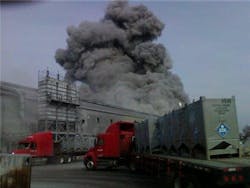EPA Introduces Overhauled Accident-Planning Rules for Chemical Plants
The U.S. Environmental Protection Agency released new rules March 1 requiring chemical manufacturers to implement extensive safeguards to protect at-risk communities from facility accidents.
The changes to the EPA's Risk Management Program (RMP), called the Safer Communities by Chemical Accident Prevention Rule, includes the EPA’s most protective safety provisions for chemical facilities in history, the EPA said in its March 1 announcement.
The ruling includes emergency planning for extreme weather events due to climate change.
The American Chemistry Council (ACC) said the ruling will lead to a "surge in misguided regulations,” singling out the mandate for chemical plants to analyze safer, alternative technologies as an unnecessary burden on chemical manufacturers.
“The agency has not provided sufficient evidence to justify these new requirements, nor has it adopted a more targeted approach to further enhance safety as suggested by ACC and other stakeholders,” said Kimberly Wise-White, ACC’s vice president of regulatory and scientific affairs in a March 1 news release. “Unfortunately, EPA has doubled down on its flawed approach, vastly expanding the scope of questionable new requirements. We urge EPA to withdraw its rule and focus on building on the success of the current program. This flawed rule is yet another example of why the White House needs to create an Interagency Policy Committee (IPC) to help improve the process for developing regulations.”
The new rules will significantly increase the financial burden of the RMP, more than tripling the anticipated costs for implementation, according to the ACC.
RMP is an EPA rule under the Clean Air Act that requires facilities using extremely hazardous substances to develop a risk management plan. The EPA regulates about 12,000 facilities under the RMP, including chemical manufacturers and distributors.
The rule protects the health and safety of all communities by requiring industry to prevent accidental releases of dangerous chemicals that could otherwise cause deaths and injuries, damage property and the environment, or require surrounding communities to evacuate or shelter-in-place, the EPA said.
In addition to the safer technologies and alternatives requirement, other final amendments to the rule include increasing employee involvement in safety measures, facilitating anonymous hazard reporting, mandating third-party audits and incident investigations following accidents, enhancing emergency planning and community notification systems, assessing risks from natural hazards and climate change, and improving public access to facility information.
ACC objects to increased information sharing, saying it poses a national security risk.
“The final rule requires companies to broadly share detailed information about specific chemical hazards at their facilities, removing important safeguards put in place after the 9/11 attacks,” ACC said in a statement. “This requirement could pose a national security threat by creating opportunities for bad actors to use sensitive information to target a facility or disrupt responses to emergencies.”
The updates are in line with the Biden administration’s environmental justice initiative. The EPA estimates that accidental releases from RMP facilities cost society more than $540 million each year. There are approximately 131 million people living within three miles of RMP facilities, of which approximately 20 million identify as Black, 32 million identify as Hispanic or Latino, and 44 million earn less than or equal to twice the poverty level, according to the EPA news release.
The administration cited the 2019 explosion and fire at the TPC Group in Port Neches, Texas, as a compelling example of why the ruling is necessary. The incident resulted in the evacuation of 50,000 people, as well as $153 million in offsite property damage.
Had the updated provisions been in effect prior to the TPC Group accident, the facility would have been required to perform a safer technologies and alternatives analysis and implement at least one safeguard measure, which may have mitigated or prevented the accident from occurring, the administration said.
About the Author
Jonathan Katz
Executive Editor
Jonathan Katz, executive editor, brings nearly two decades of experience as a B2B journalist to Chemical Processing magazine. He has expertise on a wide range of industrial topics. Jon previously served as the managing editor for IndustryWeek magazine and, most recently, as a freelance writer specializing in content marketing for the manufacturing sector.
His knowledge areas include industrial safety, environmental compliance/sustainability, lean manufacturing/continuous improvement, Industry 4.0/automation and many other topics of interest to the Chemical Processing audience.
When he’s not working, Jon enjoys fishing, hiking and music, including a small but growing vinyl collection.
Jon resides in the Cleveland, Ohio, area.

